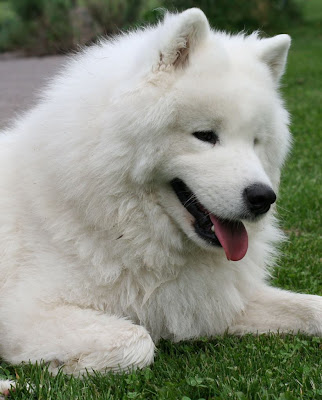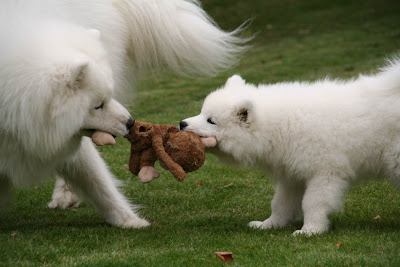The Samoyed dog takes its name from the Samoyedic peoples of
Samoyeds have a lot of vitality, and well cared for Samoyeds are known to retain their youthful, energetic spirit well into their senior years. The average lifespan for a Samoyed is 12 to 16 years. Being a working breed, they have excellent stamina, and without daily exercise they will become bored and/or depressed, which can lead to excessive barking, destruction, weight gain, irritability, and escape artist behavior. Samoyeds are typically a hardy dog, but do have their share of health concerns. They share a common resemblance with an American Eskimo dog. They may also be mistaken for Husky dogs or Japanese Spitz by inexperienced people
Size : Males typically weigh between 20-32.5 kg (55-71 lbs) and stand at a height of 54–60 cm (21–24 in) , while females typically weigh 17–25 kg(40-55 lbs) and stand at a height of 50–56 cm (19–22 in) .
Eyes : Samoyed eyes are usually black or brown and are almond in shape. The expression is often described as "intelligent". Blue or other color eyes can occur but are not allowed in the show ring.
Ears : Samoyed ears are thick and covered with fur, triangular in shape, and erect. They are almost always white but can occasionally have a light brown tint, usually around the tips of ears.
Tail : The Samoyed tail is one of the breed's more distinguishing features. Like the Alaskan Malamute, their tail is carried curled over their backs; however, unlike the Malamute, the Samoyed tail is held actually touching the back. It should not be a tight curl or held "flag" like, it should be carried lying over the back and to one side. In cold weather, Samoyeds may sleep with their tails over their noses to provide additional warmth. Almost all Samoyeds will allow their tails to fall when they are relaxed and at ease, as when being stroked or while eating, but will return their tails to a curl when more alert.
Coat: Topcoat is straight and wiry, and the undercoat is dense and short. Can be white, cream, or white with light brown.
Training : Training can be a challenge and needs to start early. Variety in the drills is key, as Samoyeds can get bored if asked to do the same task over and over and refuse to do anything. Screaming, shouting or hitting will not get the dog's respect, in fact it will produce the opposite effect. The dog will need to see you as both an authority figure and a friend. It must be trained to come to you when very young.
Samoyed Dog Club Directory
- Specialty breed club licensed by the American Kennel Club. Objectives and purposes, currently and upcoming events and rescue activities.
- Including Yapper Online newsletter.
- The association is comprised of breeders and pet owners. The site is full of information on Samoyeds, the Club, and links.
- Objectives, activities and history of this specialty breeders club.
- The Samoyed Association of Finland. Pages in Finnish and English.
- An AKC licensed group formed by breeders whose purpose is to protect the breed. News, next events and photo gallery.
- Information about their activities like rescuing and placing homeless Samoyeds, breed promotion and upcoming events.
- Provides information about their members, objectives and next events.
- Group of Samoyed owners who are involved in breeding for showing, obedience, herding and agility.
- Samoyed breed section of the CIRN, Italian Northern Breed Club.













0 comments:
Post a Comment